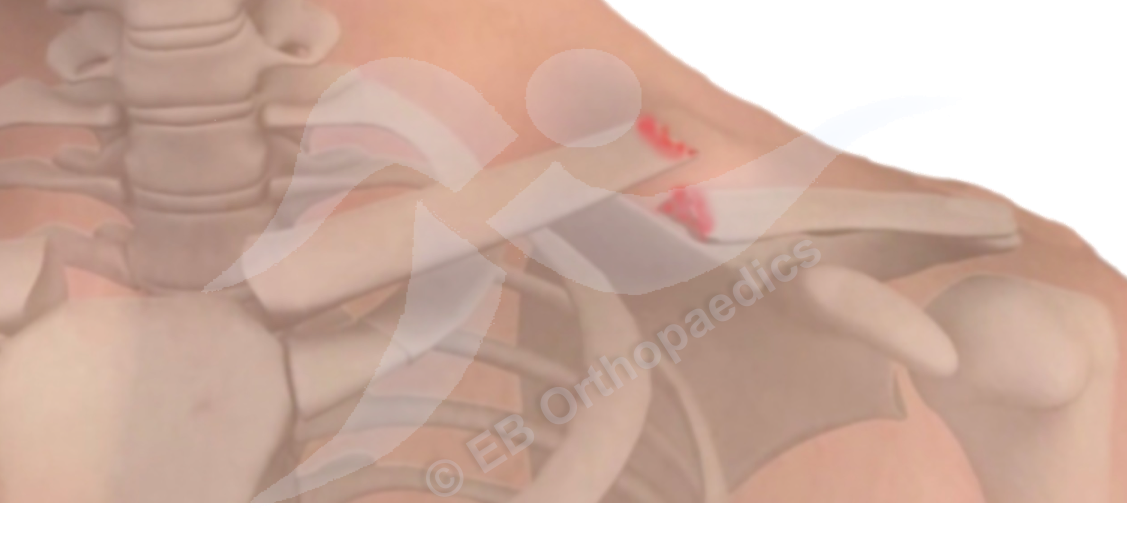Clavicle fractures

The clavicle (collar bone) is a common bone to break (fracture). The vast majority of fractures heal without the need for surgery. Sometimes if they are displaced, or are pressing significantly on the skin then they may benefit from surgery to fix them with a plate and screws.
In some cases, more commonly where the bones have been left to heal without surgery, the bones may not heal (non-union) or may heal in an incorrect position (mal-union). Mal-unions may not be a problem but some people find that if the bone heals in a shortened position that they can experience problems with certain sports and activities. If you are having symptoms from this then you may be advised to have surgery to correct the position of the bones or try and make them heal together.
One of the main risks for bones not healing is smoking, which includes vaping with nicotine.
Acute clavicle fractures
A clavicle fracture usually occurs from a fall onto an outstretched hand or from a direct impact to the shoulder.
As with any fracture, pain is the main feature. There is also bruising which can appear around the fracture site but also down the arm. It is also painful to move the shoulder and sleeping can be troublesome.
The treatment of acute (new) clavicle fractures is usually with a sling and adequate painkillers. Stopping smoking if you are a smoker will also help the bone to heal faster and reduce the possibility that it will not heal.
For some acute fractures, surgery may be advised in order to realign the fracture as close to how it was before the break if it is significantly displaced or shortened. It may also be advised it the fracture is associated with other injuries around the shoulder including breaks in the skin or where the bone is pushing against the skin causing skin problems.
Surgery aims to realign the fracture to its original length and position. It also provides initial pain relief through stability and gives a higher rate of successful healing (lower non-union rate).
After surgery you may be in a sling for up to 6 weeks but will be able to take your arm out to perform the physiotherapy exercises advised.
You will usually be able to get back to work at a couple of weeks and do light two-handed activities at 3 weeks from surgery. Strengthening work will not commence until 3 months from surgery.
Without surgery the majority of patients regain their movement and their pain settles however often a bump at the fracture site remains. In some cases if the fracture does not heal, or heals in a poor position then further surgery is required. The vast majority of people get back to full activities.
Clavicle fracture
non-unions and mal-unions
A clavicle fracture usually occurs from a fall onto an outstretched hand or from a direct impact to the shoulder. If the bones were not aligned well then it can lead to it healing in a mal-united position. In some cases if there was soft tissue in the way of the fracture, or if you were a smoker, the bones may not have healed together.
In cases of mal-union there may be an aching in the shoulder and a sense that your shoulder is not quite right. You may have problems with certain sports, particularly overhead sports.
For non-unions there may be ongoing pain and the bones may be felt to move.
If you have a non-union or mal-union your fracture will usually have been treated initially without surgery. If you have ongoing problems the option is to carry on as you are and adjust your activities to avoid symptoms, or to consider surgery.
For non-unions or mal-unions, the operation is similar to fixing a new fracture, although because the bone has tried to heal and scar tissue is present it is a bigger operation with greater risks. The aim is to get the bone re-aligned and to the correct length that is was before you broke it. You may also need some bone graft to promote the clavicle fracture healing. This is usually taken from your iliac crest (hip area) on the same side as your clavicle fracture.
If you are a smoker it is important to stop before surgery as smoking (and vaping nicotine) substantially increases the risk of the bones not healing.
After surgery you may be in a sling for up to 6 weeks but will be able to take your arm out to perform the physiotherapy exercises advised.
You will usually be able to get back to work at a couple of weeks and do light two-handed activities at 6 weeks from surgery. Strengthening work will not commence until 3 months from surgery.
Without surgery the symptoms from a mal-union or non-union may settle to some extent with time but it is usually that you just get used to avoiding particular activities which cause the symptoms. With surgery, provided the bone heals the symptoms that you were experiencing (pain and movement at the fracture site) should resolve.